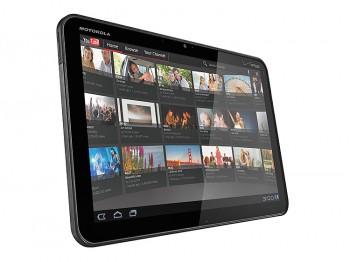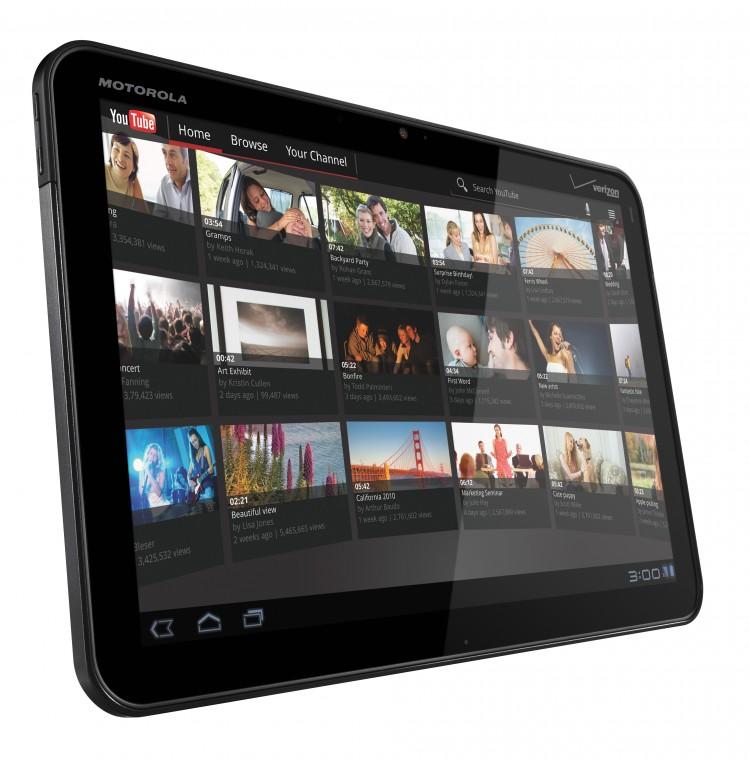Do we finally have a serious contender from the Android camp worthy of challenging the mighty iPad 2? Read on to find out!
Design
Motorola has taken the minimalistic approach with the Xoom. Other than a pinhole camera, the front of the device is dominated by a large display framed by a relatively thin black bezel. The back is casted in a black matte metal that gives it an unassuming yet classy look.
At 9.8 inches tall and 6.6 inches wide, it is surprisingly small given that it boasts a 10.1-inch screen. It feels a bit heavy in my hands although it weighs only 1.6 pounds. It is more rectangular than square, and that makes it a bit weird to hold with one hand, especially since the bezel is quite thin. The back of the device has a smooth finish that also makes it a little slippery.
The placement of the cameras and buttons, meanwhile, suggests that the Xoom is designed to be used in landscape mode, held horizontally by two hands.
Software
One of the most exciting aspects of the Xoom is its spanking new Android Honeycomb operating system that is designed specifically for tablets. Previous Android operating systems used on tablets were designed for smartphones.
The OS provides a very functional interface that feels somewhat similar to a modern desktop OS. The system bar at the bottom and navigation bar at the top makes the interface quite intuitive, but it might still take some time to learn what all the buttons and menus do.
Existing Android users will be happy to find that they are still able to customize the home screens with widgets in this new version of Android OS. Overall, the Honeycomb feels well designed for tablets and performs smoothly on the Xoom.
Hardware
The Xoom boasts the best hardware specifications of all tablets on the market right now. Equipped with a huge screen capable of displaying 1280- by 800-pixel resolution, 1 gigabyte of RAM, and a powerful dual core 1Ghz Integra 2 processor, it is more than capable of catering to any business or leisure needs.
The Xoom is stacked to the brim with all the latest technologies currently available on mobile devices, with its features including Wi-Fi and Bluetooth connectivity, aGPS, eCompass, 5MP rear camera with dual-LED flash, 2MP front camera, 1080p HDMI video output, built-in microphone and stereo speakers, accelerometer, gyroscopes, proximity sensor, ambient light sensor, and even a barometer.
It is also the first tablet to offer 4G connectivity via a free hardware upgrade that is going to be available in the near future for owners of the 3G variant, giving it fast wireless Internet connection. The only weakness I’ve found in the Xoom’s hardware is the low contrast of the display. Although the screen is bright and clear, the colors appear a little dull.
Performance
The overall impression from operating the Xoom is that it is very fast and smooth. Navigating around the multiple home screens that are loaded with widgets and switching around opened applications is quick and effortless.
All applications I used ran smoothly on the Xoom, and with the amount of graphical and computational power that it packs, we can expect more sophisticated Android applications and games to be developed for it in the near future.
Even with the massive screen and huge processing power, the Xoom still has a very impressive battery life that lasts for around 10 hours of active use.
Cameras
Both the 5MP rear camera and the 2MP front camera on the Xoom produce very satisfactory pictures and videos.
The camera application is designed very well with most of the controls easily reachable with the right thumb without having to move your hands. That being said, taking steady photos and videos with a large tablet will still take some getting used to.
Media
The Xoom excels as a multimedia entertainment device. The screen has an aspect ratio of 16:10 and is excellent to watch movies with. The Xoom is able to display 720p videos smoothly on its screen and output 1080p video to an HD TV via a mini HDMI cable. The pair of built-in speakers produce good quality stereo sound and reasonably loud volume.
The Xoom is also very flexible with media files and it is a breeze transferring and playing various types of video and audio files.
Browsing the Web on the Xoom is very smooth. The browser supports multiple tabs that allow for simple and instantaneous navigation between websites. Websites are loaded quickly and how each tab runs independently shows the superb multitasking capability of the Android OS. Add Flash support into the mix—a feature not included on the Apple iPad 2—and the Xoom is truly able to provide a full-featured Web surfing experience.
The Google Books application was enhanced for the new Honeycomb OS, and with it, the Xoom can function as a very good eBook reader. That being said, however, the reflective screen and the weight of the Xoom may limit its potential as an eBook reader.
Accessories
The first accessory most users would purchase is probably a protective cover, and Motorola has released a Portfolio Case to cater for that need. The Portfolio Case fully envelops the Xoom and offers complete protection for the device, but it comes at the price of bulkiness. The case also doubles as an adjustable stand to prop the Xoom up in a few different viewing angles. Unfortunately, unlike the iPad 2’s Smart Cover, the Portfolio Case does not automatically put the Xoom to sleep or awaken it.
Motorola also released two docking stands for the Xoom. The Standard Dock charges the Xoom and provides an auxiliary audio output port. On the other hand, the Speaker Dock comes with a HDMI output as well as a set of powerful stereo speakers.
For those who type a lot, the Motorola Wireless keyboard is a must. The keyboard connects easily to the Xoom and it complements the Android OS very well with a set of specialized Android function keys.
Verdict
The Motorola Xoom is simply the best Android tablet in the market right now. It is fast and versatile, features cutting-edge technologies, and runs a promising new tablet operating system.
The biggest setback right now is the lack of tablet-optimized Android applications, so hopefully more application developers will fill the gap in the near future to realize the Xoom’s full potential.
The good:
Multiple tabs Web browser
Flash support
Good quality cameras
Good graphical and processing power
Tablet optimized OS
The bad:
Limited applications
Slightly lower contrast screen
Heavier weight
[etRating value=“ 4.5”]






